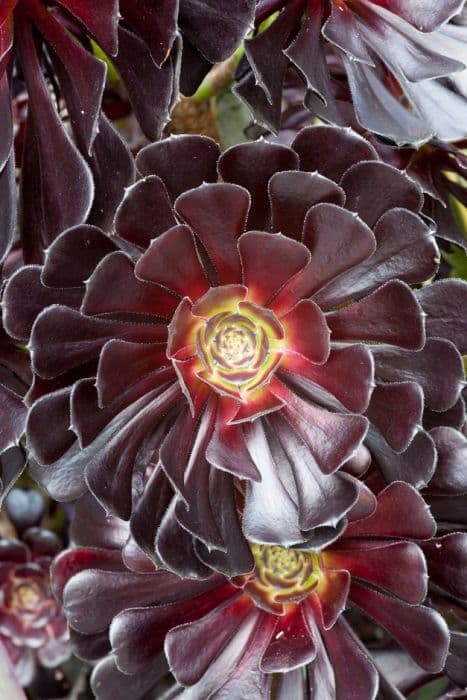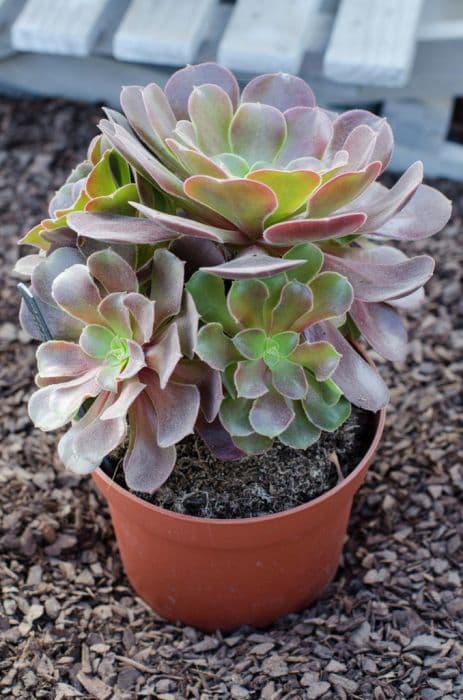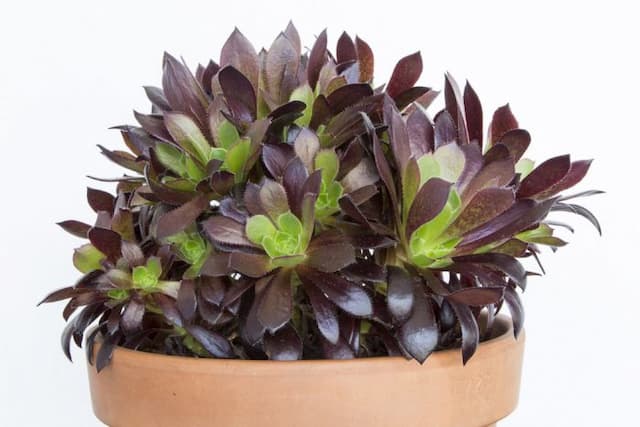Rosularia Rosularia sempervivum subsp. glaucophylla

ABOUT
The plant known most commonly as Rosularia has a distinctive appearance characterized by its rosettes of thick, fleshy leaves which are frequently likened to those of the sempervivums, to which they are closely related. The leaves boast a succulent quality and often exhibit a glaucous, or powdery, coating that gives them a slightly frosted look. Their coloration is typically a subtle green, though it can carry a bluish tinge due to the powdery layer. Over time, these rosettes can cluster together, forming dense mats. During the blooming period, the plant produces stalks that bear small, star-shaped flowers. These blossoms can be yellow, pink, or red, adding a decorative splash of color against the more muted tones of the rosettes. While it's important to note the unique visual aspects of Rosularia, we will not delve into specifics regarding its size. The plant's distinctiveness is conveyed through features such as its succulent leaves, coloration, and flowering behavior rather than its measurements.
About this plant
 Names
NamesFamily
Crassulaceae.
Synonyms
Turkish Stonecrop, Rosularia Glaucophylla.
Common names
Rosularia sempervivum (M.Bieb.) Haw., Sedum glaucophyllum (Froderstr. & G.H.Zhu) Velayos, Sedum sempervivum M.Bieb., Umbilicus glaucophyllus Froderstr. & G.H.Zhu.
 Toxicity
ToxicityTo humans
The Rosularia sempervivum subsp. glaucophylla, commonly known as the Hen and Chicks, is generally considered non-toxic to humans. There are no well-documented cases of poisoning from ingesting this plant, and it is unlikely to cause harm if accidentally consumed in small quantities. As with any non-food plant, individual sensitivities or allergic reactions are possible, but they are not commonly reported for the Hen and Chicks.
To pets
The Hen and Chicks plant is also generally considered non-toxic to pets. There is no significant evidence to suggest that this plant would cause poisoning in animals if they were to ingest parts of it. Nonetheless, pet owners should always monitor their pets and prevent them from eating large amounts of any non-food plant, as it might cause gastrointestinal upset or an unexpected allergic reaction in some cases. But overall, this particular plant is not known for being hazardous to pets.
 Characteristics
CharacteristicsLife cycle
Perennials
Foliage type
Evergreen
Color of leaves
Green
Flower color
Varies
Height
6 inches (15 cm)
Spread
12 inches (30 cm)
Plant type
Succulent
Hardiness zones
5
Native area
Turkey
Benefits
 General Benefits
General Benefits- Decorative Appeal: Adds aesthetic value to gardens with its attractive rosettes and glaucous foliage.
- Drought Tolerance: It requires minimal watering, making it suitable for xeriscaping and water-efficient gardening.
- Low Maintenance: It's easy to care for, requiring little attention beyond basic needs, perfect for novice gardeners.
- Propagates Easily: Can produce offsets or "chicks" that can be separated to grow new plants, offering a simple way to expand your garden.
- Pest Resistant: Generally resistant to pests, decreasing the need for chemical interventions in the garden.
- Tolerates Poor Soil: Can grow in less fertile soils, which makes it a good choice for challenging garden spots.
- Cold Hardy: Has the ability to withstand colder temperatures, providing year-round greenery in many climates.
 Medical Properties
Medical PropertiesThis plant is not used for medical purposes.
 Air-purifying Qualities
Air-purifying QualitiesThis plant is not specifically known for air purifying qualities.
 Other Uses
Other Uses- Landscape Design: Rosularia sempervivum subsp. glaucophylla, commonly known as bead rosettes, can be utilized in rock gardens due to its attractive foliage and ability to thrive in poor soil conditions.
- Water Conservation: Bead rosettes are drought-tolerant, making them suitable for xeriscaping or water-efficient landscaping practices.
- Green Roofing: The plant's hardiness and low growth habit make it an excellent choice for green roof installations where maintenance is minimal.
- Erosion Control: Bead rosettes can help prevent soil erosion in sloped areas of the garden due to their mat-forming growth.
- Fairy Gardens: Its miniature size and shape make bead rosettes a popular choice for creating whimsical fairy garden designs.
- Seasonal Decor: During the winter months, bead rosettes can add evergreen interest to otherwise barren gardens or outdoor spaces.
- Photographic Subject: Enthusiasts of botanical photography may appreciate the unique form and textures of bead rosettes for close-up shots.
- Education: Bead rosettes can be used to teach about vegetative propagation, as they easily produce offsets for replanting.
- Container Gardening: Due to its compact size, the plant can be grown in containers, ideal for balconies and small spaces.
- Artistic Inspiration: The geometric patterns and symmetry of bead rosettes can inspire artists and designers for various creative projects.
Interesting Facts
 Feng Shui
Feng ShuiThe Hen and chicks is not used in Feng Shui practice.
 Zodiac Sign Compitability
Zodiac Sign CompitabilityThe Hen and chicks is not used in astrology practice.
 Plant Symbolism
Plant Symbolism- Resilience: This plant is known for its hardiness and ability to survive in tough conditions, which can symbolize a person's ability to endure challenges and bounce back from adversity.
- Protection: Rosularia sempervivum, commonly known as Hens and Chicks, often grows in dense clusters that can symbolize unity and the collective effort to protect each other.
- Longevity: With its 'sempervivum' meaning 'always alive,' it suggests endurance and the concept of lasting or eternal life.
- Adaptability: The ability of Hens and Chicks to adapt to various environmental conditions can symbolize flexibility and the capacity to thrive in different situations.
 Water
WaterThe Hen and Chicks succulent should be watered sparingly, as it is drought tolerant. Water deeply, but infrequently, allowing the soil to dry completely between waterings, typically once every two weeks. During the active growing season in spring and summer, provide about a quarter to half a gallon of water per plant, depending on its size. Cut back on watering in the fall and winter to once a month or less, as the plant enters a dormancy period and requires even less moisture.
 Light
LightHen and Chicks thrive best in full sun to partial shade. Place the plant in a location where it receives at least 6 hours of sunlight each day. If grown indoors, a south-facing window is ideal to provide the bright light this succulent needs to maintain its compact form and vibrant colors.
 Temperature
TemperatureHen and Chicks prefer a temperature range between 65 and 75 degrees Fahrenheit but can tolerate temperatures as low as 40 degrees and as high as 90 degrees Fahrenheit. Avoid exposing the plant to temperatures below freezing, as it may not survive the extreme cold.
 Pruning
PruningPrune Hen and Chicks to remove dead or damaged leaves and to maintain its shape. Pruning is also necessary to cut off the dead flower stalks after blooming. Do this annually, preferably in the early spring or after flowering. Regular pruning can also stimulate new growth and keep the plant looking its best.
 Cleaning
CleaningAs needed
 Soil
SoilThe Hen and Chicks plant prefers well-draining soil with a mix of one part potting soil, one part perlite or coarse sand, and some peat for added acidity. A soil pH around 6.0 to 7.5 is ideal for this succulent.
 Repotting
RepottingHen and Chicks should be repotted every 2 to 3 years or when it outgrows its container to refresh the soil and provide room for growth.
 Humidity & Misting
Humidity & MistingHen and Chicks thrive best in dry air conditions and do not require high humidity levels, making them well-suited for indoor environments with average home humidity.
 Suitable locations
Suitable locationsIndoor
Place Hen and Chicks in bright, indirect light inside.
Outdoor
Plant Hen and Chicks in full sun to partial shade outside.
Hardiness zone
5-8 USDA
 Life cycle
Life cycleRosularia sempervivum subsp. glaucophylla, commonly known as the Hens and Chicks, begins its life cycle as a seed that germinates in well-draining soil with sufficient light exposure. The seedling develops primary roots and a rosette of succulent leaves, which is the characteristic form of its vegetative state. As the plant matures, it produces offsets or "chicks," which are small rosettes that emerge from the base of the "hen" or main plant, spreading asexually. During its reproductive stage, it sends up a flower stalk, typically in the warmer months, featuring star-shaped flowers. After flowering, which is often followed by the main rosette dying, the plant sets seed, completing its sexual reproductive cycle. The chicks then continue to grow and propagate the species, sustaining the life cycle of Hens and Chicks.
 Propogation
PropogationPropogation time
Spring to Summer
Rosularia sempervivum subsp. glaucophylla, commonly known as roseroot or roseroot sempervivum, is most successfully propagated through the division of offsets, a process best done in spring or early summer. Offsets are small, almost fully formed mini plants that grow from the base of the parent plant. To propagate, gently remove an offset and allow the cut end to callous for a few days to prevent rot. Once calloused, plant the offset in well-draining soil, ideally a mix of potting soil and coarse sand or perlite, and water sparingly until the roots establish. New growth will indicate successful propagation.









